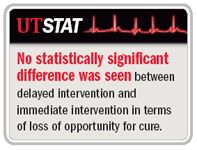Article
Active surveillance: Viable in select in prostate cancer patients
Atlanta-The decision about when to intervene in patients with small, low-grade prostate tumors can be a tough one for both patient and physician. A study from The Johns Hopkins Hospital, Baltimore, suggests that these men may have 2 years or longer to make a decision without compromising effective treatment.

"There is no question that we are over-treating a fair number of men. If we can identify those men who may not need treatment during their lifetime, then we can spare them the morbidity associated with the varied interventions," Christopher Warlick, MD, PhD, chief resident at Johns Hopkins, told Urology Times.
The study presented here at the AUA annual meeting by Dr. Warlick, H. Ballentine Carter, MD, and colleagues is a step in that direction.
This study is an update of a prospective observational study begun in 1995 for patients determined to be at favorable risk: older patients with a PSA density of less than 0.15, stage T1c disease or lower, Gleason sums <7, no more than two of 12 biopsy cores evidencing cancer, and no core containing more than 50% cancer tissue.
"Twelve-core is our standard biopsy, and men must undergo a second confirmatory 12-core biopsy to enter the expectant management program. The reason is that there can be significant understaging in men who come to our institution with just a single 12-core biopsy or a 6-core. We repeat the biopsy to ensure they have low-grade, low-volume disease," Dr. Warlick said.
Two-thirds qualify
Data not presented at the meeting but available from Johns Hopkins show that of the men who undergo these second, confirmatory biopsies, 39% will show no cancer, 31% will qualify for expectant management, and 30% will evidence cancer extensive enough or of a grade high enough to warrant immediate intervention. The researchers estimate that two-thirds of those undergoing confirmation biopsies will qualify for the expectant management program.
These men are then followed with digital rectal exams and PSA testing twice yearly and an annual surveillance biopsy. A change in PSA usually prompts a biopsy. Clinical parameters indicating a need for treatment include a change in biopsy findings, such as three cores positive, Gleason grade 4 or 5, and/or >50% cancer in any single core.
Thirty-eight patients met these parameters and underwent surgical intervention at a mean of 26.5 months after entering the expectant management program. Non-curable cancer, defined as pathology associated with a less than 75% chance of remaining biochemically disease-free for 10 years after surgery, was diagnosed in nine (23%) of the men in the delayed intervention cohort. Non-curable cancer was diagnosed in 24 (16%) of 150 men in an immediate intervention group who would have qualified for expectant management but who chose to undergo surgery immediately after diagnosis.
Data were adjusted for age and PSA density with a Mantel-Haenszel analysis. This showed a relative risk for delayed intervention compared with immediate intervention of 1.08. In short, no statistically significant difference was seen between delayed intervention and immediate intervention in terms of loss of opportunity for cure.
Dr. Warlick acknowledged that the numbers in the study were small and noted that a large, new international study, the Surveillance Therapy Against Radical Treatment (START) study, would compare surveillance to immediate intervention in larger cohorts of men.















